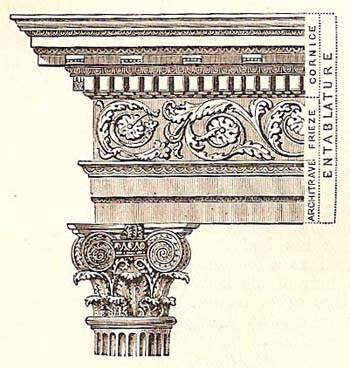cornice

An example of composite entablature.
A cornice is the upper portion of the entablature. The cornice is divided into several parts. The lower molding or moldings resting on the frieze are called the bed-moldings, the lower member of the upper projecting part is called the corona, and between the two there are frequently introduced modillions and dentil bands. The bed-molding is generally of an oval or echinus form, and is frequently enriched with the egg and tongue or leaf ornaments. The upper molding of the corona is generally of a cyma recta form, and is often ornamented with lions' heads. These represent the openings through which rain was at first led off from the roof-gutters cut in the top of this molding, and were retained as ornaments after their original use was discontinued. The corona projects well over the frieze and architrave, and protects them from rain, while at the same time, by its broad shadow, it gives repose and variety of effect to the building. The soffit, or underside of the corona, is frequently paneled and ornamented with paterae.
